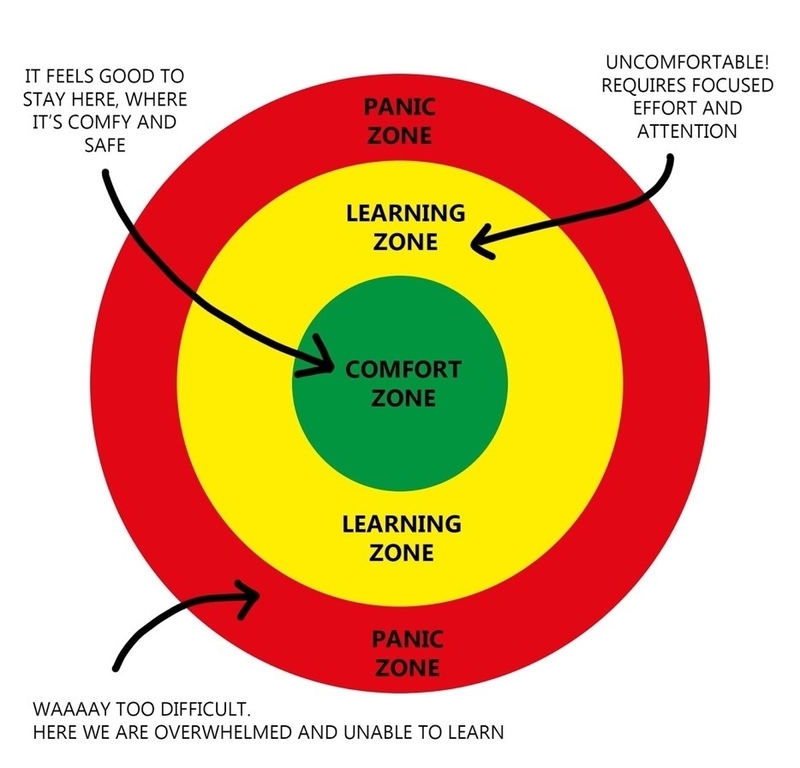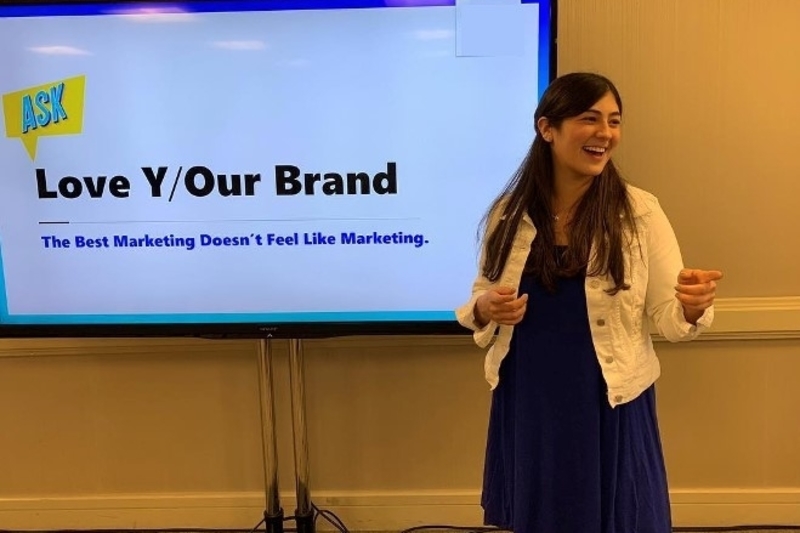Park Perspectives: How a mental shift can help overcome challenges

Rachel Starr Two Year MBA '22 in her 'orange zone' while studying abroad.
Park Perspectives are authored by Johnson’s Park Leadership Fellows.
The concept of comfort zone colors seemed foreign, and honestly a bit silly to me, when the VP of Marketing at my previous company first introduced the idea. We were sitting in her office surrounded by budget binders and excel documents as I was walking her through the current fiscal spend for the marketing department. She let out a sigh of frustration at the complexity of it all then fixed her gaze on me, “I don’t know how you manage to track this. I would have thrown these excel sheets in the trash months ago.”
I laughed and thought about how difficult it was for me to manage all of this. I pride myself on my ability to think creatively, manage projects, and stay organized, but if I had to choose an area to improve on, it would be the quantitative side of business. I decided to tell her this and she nodded approvingly.
“So, you’re in your orange zone right now,” she said matter-of-factly.
I gave her a puzzled look and she went on to explain the concept that has influenced my thinking and leadership mindset to this day.
The comfort zone colors and what they mean for growth

Comfort zone colors are a simple way to quantify how someone is feeling in a certain stage of their life. Feeling like one is in her green zone means she is comfortable and feels safe. Identifying her zone as orange means she is outside of her comfort zone and feels slightly uncomfortable, but it’s manageable to continue on with the experience. Red zone, on the other hand, is considered the fear-inducing zone. If someone is in her red zone, she is too far removed from her comfort zone and most likely paralyzed from discomfort. A red zone is a no-go zone.
Being in one’s orange zone, however, is the place where growth happens.
After the conversation with my VP I realized I was in my green zone at work. I had been at the company for over a year—and while I loved the work I was doing, I was too comfortable. I looked up to the VP of Marketing and her matter-of-fact way of keeping her team informed on her thought process when it comes to improving the department, overcoming business challenges, and pushing them all for individual growth. I was motivated intrinsically to strive for this individual growth myself, and decided to challenge myself by diving headfirst into more quantitively focused business responsibilities.
I decided to meet with the head of Account Strategy to request to be trained in our data-research tools.
I still remember that meeting—she furrowed her brow and gave me a quizzical look, almost as if saying, “are you sure”? Still, I was passionate about improving my ability to collect data and analyze it; I wanted the opportunity to learn all sides of marketing, even the numbers-heavy side.
I sat in on countless data trainings and within the year was writing research-focused decks that relied heavy on data quantifying and analyzing. As I presented one of those decks to the entire company of over 200 employees the VP of Marketing gave me an approving look and mouthed the question, “green zone?”

Her supportive but inquisitive words made me take a step back and look at my career holistically. I loved my job but I was at a point where my orange zone had become my green. I had challenged myself to look for new ways to step outside my comfort zone and it felt like it was time to move on to the next chapter…but what was that? How could I take my passion and knowledge of storytelling, consumer insights and put myself back into my orange zone? As I went through the days at work putting together brand decks and researching target audiences, I began to realize the answer to my question.
Business school.
My time in the red zone
When I was accepted into business school at Johnson, I was excited to step into my orange zone and embrace my new classmates, professors, and challenges. As I acclimated to the virtual environment (I feel confident in saying that was an orange zone for a lot of people, professors and students alike), I found myself struggling with one aspect of business school to the point where it was almost unbearable: Financial Accounting class.
My inability to love Financial Accounting stumped my accountant father and numbers-obsessed twin sister. How could I have ended up so differently than them? My twin did not suffer from the same panic-state that took over as soon as I looked at a math problem. As my professor looked around the Zoom room for volunteers, I felt my brain shut down and my eyes get blurry as I struggled to motivate myself to attempt the problem. I knew I was more of a creative person, but I had never experienced a debilitating lack of focus when it comes to solving a math question before. I felt so uncomfortable sitting in class every day unable to process how to work through a bad-debt expense write-off or how to put together an operating cash flow statement until I finally realized what was happening. I was in my red zone.
I sat with this feeling for a few days, trying to think about how to change my mindset so I could take the pressure off of me when it came to solving Financial Accounting problems.
Soon after this realization, we had a Park Leadership Fellows session on different leadership styles that highlighted some key attributes we all have as leaders.
I found out through this assessment that I was a person who appreciated creative challenges and using gut feelings and creative solutions to overcome obstacles. It made sense. I loved marketing because I could decide the story. I could look at consumer data and insights and decide how we wanted to communicate with our target audience. I could see what competitors are doing and adapt. The element of marketing and brand management that fascinated and played to my strengths was this idea that we could be flexible, we could adapt. Financial Accounting, on the other hand, made it so that if you made one mistake, or didn’t follow one step, that was it, it was wrong.
Once I figured out that this key difference was what was causing my fear of attempting math problems, I tried to figure out what I could control. As a leader, it is important to recognize that we can’t control a lot, so it is up to us to identify what we can change and put our energy into that. I couldn’t change the rules of accounting, just like I couldn’t change how the professor graded the assignments, but I could change how I viewed Financial Accounting and how I prepared for the exams.
Something’s gotta give: How I learned to re-frame my mindset
I began viewing Financial Accounting as a game.
If you see this word that means you do this step, if you see this number next to an asset without the corresponding amount in liabilities and stockholder’s equity, then you need to find this. Instead of viewing the problem as one giant overwhelming issue, I picked apart each piece into manageable parts.
I could do this! I remember thinking as I studied for our first quiz. Reading the entire problem, I still felt panicked and my eyes started to glaze over as I became overwhelmed with all that the question was asking. Before I let myself fall into that same trap, I broke the problem apart into separate pieces, almost like how I would approach a marketing problem. We see we need to find the inventory amount (our target audience), how do we go about calculating it (how do we quantify the total target audience we want to reach)? Approaching the problems this way helped me change my mentality about a class that had been a thorn in my side for so long.
I learned through this mindset change and thought process switch how strong a leader I could really be. When faced with challenges that are daunting and seem overwhelming, it’s important to be able to pick a part the problems and figure out what we as leaders can control. That’s how we put ourselves back into the orange zone. That’s how we grow.
Our classmates and our teams will look to us to lead the way during uncertain times when they find themselves in their own red zones, so learning how to do this process during business school is the best way to get ready for the real world. Not to mention, it is pretty cool to say you know how to write-off bad debts if it ever comes up in a conversation—but sorry dad, I don’t think I’ll be going into the family business.

